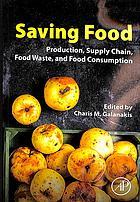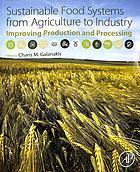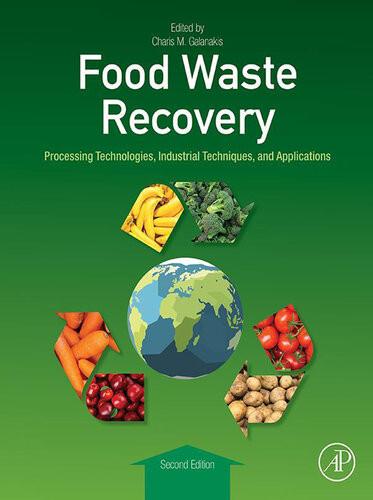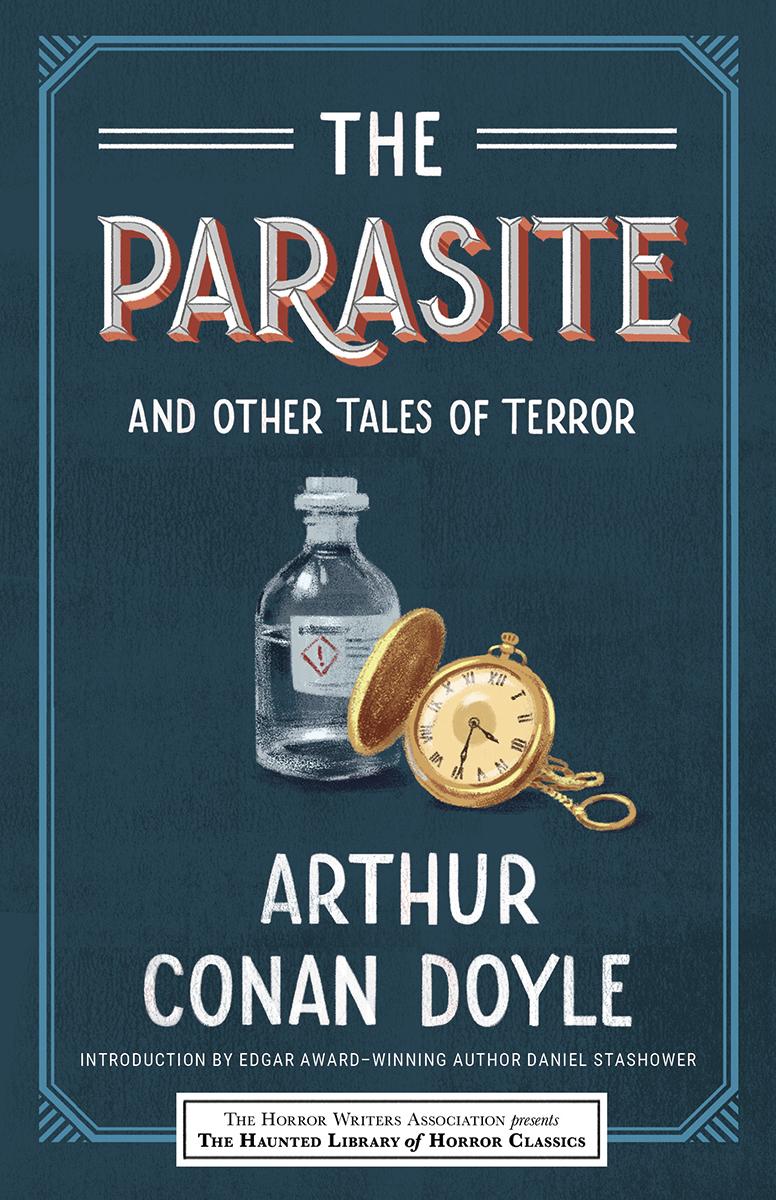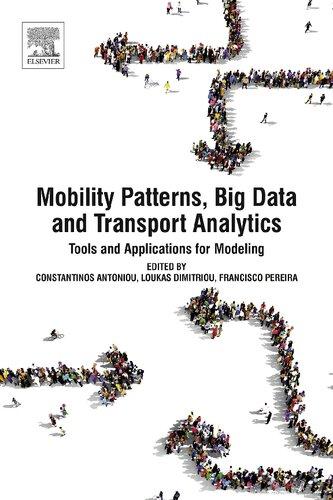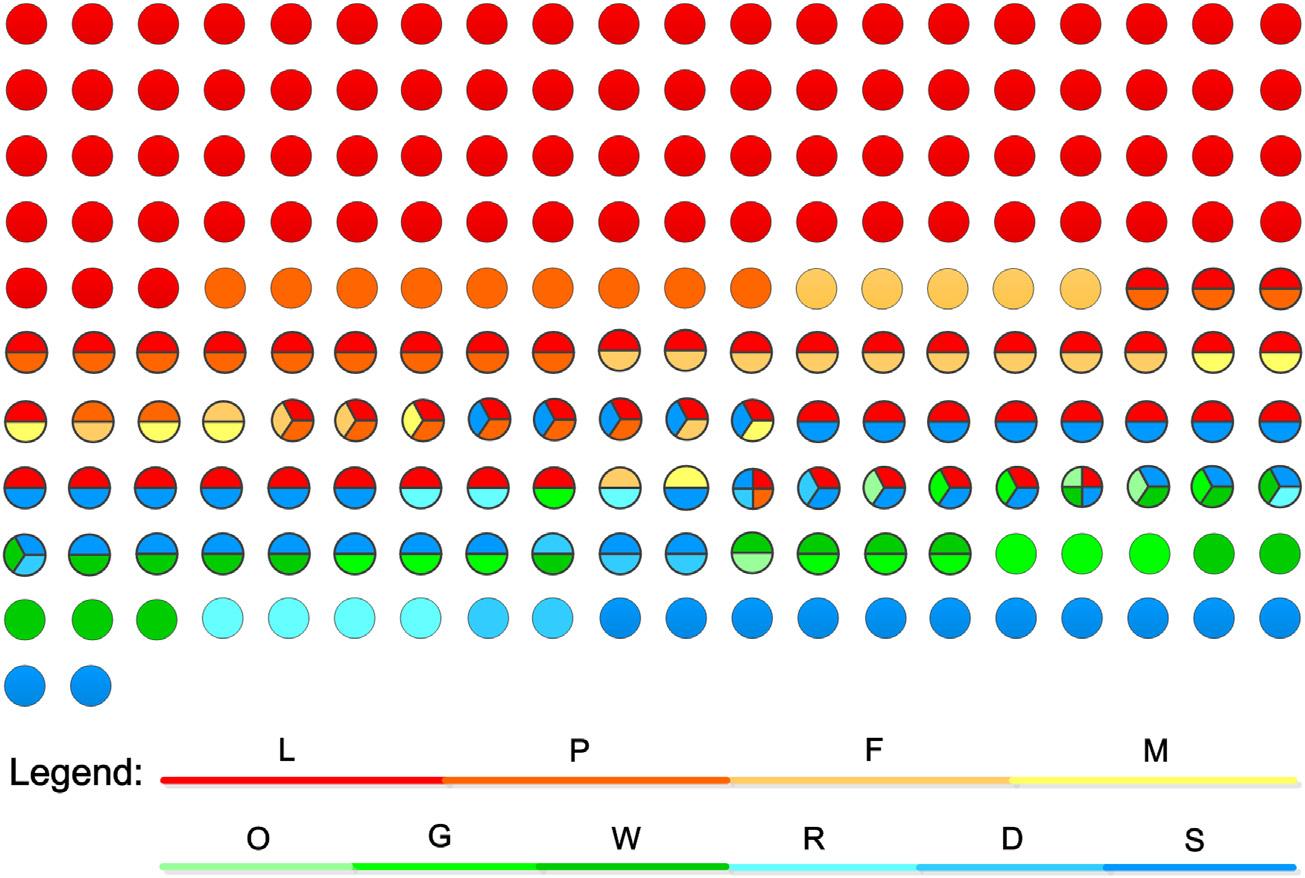https://ebookmass.com/product/saving-food-production-supply-
Instant digital products (PDF, ePub, MOBI) ready for you
Download now and discover formats that fit your needs...
Sustainable Food Systems from Agriculture to Industry Improving Production and Processing Galanakis
https://ebookmass.com/product/sustainable-food-systems-fromagriculture-to-industry-improving-production-and-processing-galanakis/
ebookmass.com
Food Waste Recovery: Processing Technologies, Industrial Techniques, and Applications 2nd Edition Charis M. Galanakis
https://ebookmass.com/product/food-waste-recovery-processingtechnologies-industrial-techniques-and-applications-2nd-editioncharis-m-galanakis/
ebookmass.com
Food Quality and Shelf Life Charis M. Galanakis
https://ebookmass.com/product/food-quality-and-shelf-life-charis-mgalanakis/ ebookmass.com
Siegfried Kracauer, or, The Allegories of Improvisation: Critical Studies 1st
Edition Miguel Vedda
https://ebookmass.com/product/siegfried-kracauer-or-the-allegories-ofimprovisation-critical-studies-1st-edition-miguel-vedda/
ebookmass.com
Pegasus: The Story of the World's Most Dangerous Spyware
Laurent Richard
https://ebookmass.com/product/pegasus-the-story-of-the-worlds-mostdangerous-spyware-laurent-richard/
ebookmass.com
The Parasite and Other Tales of Terror Arthur Conan Doyle
https://ebookmass.com/product/the-parasite-and-other-tales-of-terrorarthur-conan-doyle/
ebookmass.com
Secret Lives Mark De Castrique
https://ebookmass.com/product/secret-lives-mark-de-castrique-5/
ebookmass.com
Mobility Patterns, Big Data and Transport Analytics: Tools and Applications for Modeling Constantinos Antoniou (Editor)
https://ebookmass.com/product/mobility-patterns-big-data-andtransport-analytics-tools-and-applications-for-modeling-constantinosantoniou-editor/
ebookmass.com
Sayings of Gorakhnath: Annotated Translation of the Gorakh
Bani Gordan Djurdjevic
https://ebookmass.com/product/sayings-of-gorakhnath-annotatedtranslation-of-the-gorakh-bani-gordan-djurdjevic/
ebookmass.com
Social Work Practice with Families A Resiliency-Based Approach 3rd Edition Mary Patricia Van Hook
https://ebookmass.com/product/social-work-practice-with-families-aresiliency-based-approach-3rd-edition-mary-patricia-van-hook/
ebookmass.com
SavingFood
Editedby
AcademicPressisanimprintofElsevier 125LondonWall,LondonEC2Y5AS,UnitedKingdom 525BStreet,Suite1650,SanDiego,CA92101,UnitedStates 50HampshireStreet,5thFloor,Cambridge,MA02139,UnitedStates TheBoulevard,LangfordLane,Kidlington,OxfordOX51GB,UnitedKingdom
Copyright©2019ElsevierInc.Allrightsreserved.
Nopartofthispublicationmaybereproducedortransmittedinanyformorbyanymeans,electronicor mechanical,includingphotocopying,recording,oranyinformationstorageandretrievalsystem,without permissioninwritingfromthepublisher.Detailsonhowtoseekpermission,furtherinformationaboutthe Publisher’spermissionspoliciesandourarrangementswithorganizationssuchastheCopyrightClearance CenterandtheCopyrightLicensingAgency,canbefoundatourwebsite: www.elsevier.com/permissions.
ThisbookandtheindividualcontributionscontainedinitareprotectedundercopyrightbythePublisher (otherthanasmaybenotedherein).
Notices
Knowledgeandbestpracticeinthisfieldareconstantlychanging.Asnewresearchandexperiencebroaden ourunderstanding,changesinresearchmethods,professionalpractices,ormedicaltreatmentmaybecome necessary.
Practitionersandresearchersmustalwaysrelyontheirownexperienceandknowledgeinevaluatingand usinganyinformation,methods,compounds,orexperimentsdescribedherein.Inusingsuchinformation ormethodstheyshouldbemindfuloftheirownsafetyandthesafetyofothers,includingpartiesforwhom theyhaveaprofessionalresponsibility.
Tothefullestextentofthelaw,neitherthePublishernortheauthors,contributors,oreditors,assumeany liabilityforanyinjuryand/ordamagetopersonsorpropertyasamatterofproductsliability,negligenceor otherwise,orfromanyuseoroperationofanymethods,products,instructions,orideascontainedinthe materialherein.
BritishLibraryCataloguing-in-PublicationData
AcataloguerecordforthisbookisavailablefromtheBritishLibrary LibraryofCongressCataloging-in-PublicationData
AcatalogrecordforthisbookisavailablefromtheLibraryofCongress
ISBN:978-0-12-815357-4
ForInformationonallAcademicPresspublications visitourwebsiteat https://www.elsevier.com/books-and-journals
Publisher: CharlotteCockle
AcquisitionEditor: MeganBall
EditorialProjectManager: LauraOkidi
ProductionProjectManager: NileshKumarShah
CoverDesigner: MatthewLimbert
TypesetbyMPSLimited,Chennai,India
Listofcontributors
ElisabeteM.C.Alexandre QOPNA&LAQV-REQUIMTE,Departmentof Chemistry,UniversityofAveiro,Aveiro,Portugal;CenterforBiotechnologyand FineChemistry AssociatedLaboratory,SchoolofBiotechnology,Catholic UniversityofPortugal,Porto,Portugal
Vale ´ rieL.Almli SensoryandConsumerScienceDepartment,Nofima,A ˚ s, Norway
GracielaAlvarez RefrigerationProcessEngineeringResearchUnit,IRSTEA, Antony,France
JessicaAschemann-Witzel MAPPCentre,DepartmentofManagement,Aarhus SchoolofBusinessandSocialSciences,AarhusUniversity,Aarhus,Denmark
CarlaCaldeira EuropeanCommission,JointResearchCentre(JRC),Ispra,Italy
SaraCorrado EuropeanCommission,JointResearchCentre(JRC),Ispra,Italy
ChristineCostello AssistantProfessor,Industrial&ManufacturingSystems Engineering,UniversityofMissouri,Columbia,MO,UnitedStates
IlonaE.deHooge MarketingandConsumerBehaviourgroup,Wageningen University,Wageningen,TheNetherlands
HansDeSteur DepartmentofAgriculturalEconomics,FacultyofBiosciences Engineering,GhentUniversity,Ghent,Belgium
ManojK.Dora CollegeofBusiness,Arts&SocialSciences,BrunelBusiness School,BrunelUniversity,London,UnitedKingdom
GabrieldaSilvaFilipini FederalUniversityofRioGrande,SchoolofChemistry andFood,RioGrande,Brazil
XavierGellynck DepartmentofAgriculturalEconomics,FacultyofBiosciences Engineering,GhentUniversity,Ghent,Belgium
SelaleGlaue EfesVocationalSchool,DokuzEylulUniversity, ˙ Izmir,Turkey
NihanGogus EfesVocationalSchool,DokuzEylulUniversity, ˙ Izmir,Turkey
TizianoGomiero Independentscholar,Treviso,Italy
GangLiu SDULifeCycleEngineering,DepartmentofChemicalEngineering, Biotechnology,andEnvironmentalTechnology,UniversityofSouthernDenmark, Odense,Denmark
LaraManzocco DepartmentofAgricultural,Food,EnvironmentalandAnimal Sciences,UniversityofUdine,Udine,Italy
PaolaChavesMartins FederalUniversityofRioGrande,SchoolofChemistry andFood,RioGrande,Brazil
Vila ´ siaGuimara ˜ esMartins FederalUniversityofRioGrande,Schoolof ChemistryandFood,RioGrande,Brazil
UltanMcCarthy SchoolofScience&Computing,DepartmentofScience, WaterfordInstituteofTechnology,Waterford,Ireland
SamuelMercier DepartmentofElectricalEngineering,UniversityofSouth Florida,Tampa,FL,UnitedStates;DepartmentofChemicalandBiotechnological Engineering,Universite ´ deSherbrooke,Sherbrooke,QC,Canada
MartinMondor Saint-HyacintheResearchandDevelopmentCentre,Agriculture andAgri-FoodCanada,Saint-Hyacinthe,QC,Canada
Sı´lviaA.Moreira QOPNA&LAQV-REQUIMTE,DepartmentofChemistry, UniversityofAveiro,Aveiro,Portugal;CenterforBiotechnologyandFine Chemistry AssociatedLaboratory,SchoolofBiotechnology,CatholicUniversity ofPortugal,Porto,Portugal
SemihOtles FoodEngineeringDepartment,EgeUniversity, Izmir,Turkey
AdityaParmar NaturalResourcesInstitute,UniversityofGreenwich,London, UnitedKingdom
DarianPearce DepartmentofAgriculturalEconomics,FacultyofBiosciences Engineering,GhentUniversity,Ghent,Belgium
ManuelaPintado CenterforBiotechnologyandFineChemistry Associated Laboratory,SchoolofBiotechnology,CatholicUniversityofPortugal,Porto, Portugal
CarlosA.Pinto QOPNA&LAQV-REQUIMTE,DepartmentofChemistry, UniversityofAveiro,Aveiro,Portugal
StellaPlazzotta DepartmentofAgricultural,Food,EnvironmentalandAnimal Sciences,UniversityofUdine,Udine,Italy
VivianePatrı´ciaRomani FederalUniversityofRioGrande,SchoolofChemistry andFood,RioGrande,Brazil
SerenellaSala EuropeanCommission,JointResearchCentre(JRC),Ispra,Italy
JorgeA.Saraiva QOPNA&LAQV-REQUIMTE,DepartmentofChemistry, UniversityofAveiro,Aveiro,Portugal
TaijaSinkko EuropeanCommission,JointResearchCentre(JRC),Ispra,Italy
DespoudiStella AstonBusinessSchool,AstonUniversity,Birmingham,United Kingdom
SebnemTavman FoodEngineeringDepartment,EgeUniversity, Izmir,Turkey
IsmailUysal DepartmentofElectricalEngineering,UniversityofSouthFlorida, Tampa,FL,UnitedStates
SebastienVilleneuve Saint-HyacintheResearchandDevelopmentCentre, AgricultureandAgri-FoodCanada,Saint-Hyacinthe,QC,Canada
JoshuaWesana DepartmentofAgriculturalEconomics,FacultyofBiosciences Engineering,GhentUniversity,Ghent,Belgium;SchoolofAgriculturaland EnvironmentalSciences,MountainsoftheMoonUniversity,FortPortal,Uganda
LiXue InstituteofGeographicSciencesandNaturalResourcesResearch,Chinese AcademyofSciences,Beijing,P.R.China;SDULifeCycleEngineering, DepartmentofChemicalEngineering,Biotechnology,andEnvironmental Technology,UniversityofSouthernDenmark,Odense,Denmark;Universityof ChineseAcademyofSciences,Beijing,P.R.China
Preface
Aboutone-thirdofthefoodproducedintheworldforhumanconsumptiongetslost orwastedeveryyear.Thisquantityisshockingconsideringthatitaccountsapproximatelyfor1.3billiontonsoffood.Asitcanbeeasilyunderstood,theproblemof foodlossandwasteisdirectlyconnectedtohungerandglobalsustainabilityinthe 21stcentury.However,theproblemisevenbiggerthanitseems,asfoodlossalso accompaniesamajorsquanderingofresourcessuchaswater,land,energy,labor, andcapital.Inaddition,itisconnectedtoincreasedandunwantedgreenhousegas emissionsthatcontributetoglobalwarmingandclimatechange.Theproblemof foodlossandfoodwasteissobigthatitcannotbesolvedwithmereactivitiesor simplesuggestions.Itcanbeeliminatedonlybyfacingchallengesandproviding continuoussolutions,atalllevelsoffoodproductionandconsumptionforallthe involvedactorsandstakeholders.Correctingthepolicyframework,optimizingagriculturalpractices,shapingfoodproduction,changingconsumers’andcompanies’ attitudes,motivatingretailers,promotingpackagingandprocesstechnologies,valorizingwastestreams,andotheractionsshouldalsobetakenintoaccount.
Subsequently,aguidecoveringthelatestdevelopmentsinthisparticulardirectionisrequired.Thisbookfillsthesegapsbycoveringalltheaspectsoffood-loss reductionatallrelevantstagesandinallpossibleways.Itprovidesdetailsabout introducingsustainablefoodproduction,adaptingmoresustainablemethodsfor efficientcropcultivationandharvesting,optimizingutilizationofresources,eliminatinglossesinthesupplychain,adaptingsustainablepackagingsolutions,appealingenterprisestochangeconsumerbehavior,developingfoodwastevalorization strategies,andraisingpeople’sawarenessofwastedfood.Theultimategoalisto supportthescientificcommunity,policymakers,professionals,andenterprises,that aspiretosetupactionsandstrategies,toreducewastageoffood.Thereby,thebook targetsallinvolvedactorsandaimstodriveinnovations,promoteinterdisciplinary dialogues,andsparkdebatestogeneratesolutionsacrosstheentirevaluechain fromfieldtofork.
Itconsistsof13chapters.Chapter1providesanintroductiontoglobalfoodloss andfoodwasteusingdatafor84countriesand52individualyears.Chapter2 reviewssoilandcropmanagementpracticesthatmayreduceyieldloss,or increaseyields,whilereducingtheuseofinputsandtheenvironmentalimpactof agriculturalactivities.Anumberoffoodlossreductionmeasures(technicaland behavioral)areavailablealongtheentirevaluechain,butthemotivationtoimplementthemistheonethatneedsdueconsiderationandaction.Furtheroptimization ofagriculturalpracticestosavefoodisdescribedinChapter3.
Duringfoodproduction,transport,storage,andfinalconsumption,thefoodpropertiesmaygetaffectedinseveralways.Toensuresafetyandstabilityoffoodsand avoidtheirdischarge,effectiveandeconomicfoodpreservationmethodsshouldbe selected.Chapter4dealswiththeconventionalandemergingpreservation techniques,suchaspasteurization,sterilization,cooling,freezing,ohmicheating, microwave,andradiofrequency,whicharethermalpreservationtechnologies.On theotherhand,Chapter5dealswiththeapplicationofnonthermalandeco-friendly emergentprocessingmethodologiessuchashighpressureprocessing,pulsedelectricfields,andultrasounds.Thesemoderntechnologiesassureproducts’safetyas wellasmaintaintheiroriginalquality,thuscontributingtofoodlossreductionduringproduction.
Anefficientwaytopreservefoodisusingindustrialprocesses,butitisalso possibletouseactivepackagingtoextendtheshelflifeoffoodproducts.Tothis end,Chapter6discussesexistingandinnovativepackagingsolutionstominimize foodwaste.Chapter7reviewsthemainstagesandtechnologiesusedforthepreservationofperishablefoodproductsalongthesupplychain,andtheamountoffood lostorwastedalongthesestagesforthemainfamiliesofproducts.Italsohighlights theneedforbetterrefrigerationoffoodalongthelaststagesofthecoldchain(retail andconsumerhandling)andforbettermanagementalongthecommercialportion ofthecoldchainindevelopedcountries.Chapter8aimstoprovideanoverviewon lossesinthefoodindustry.Atfirst,foodlossesintheupstreamanddownstream supplychainarediscussedpriortodenotingthedifferentwaystoreducefood lossesbyoptimizingsupplychains.Solutionsatthesupplychainentity levelas wellassupplychainnetwork levelareprovided.Chapter9presentsmitigating approachesthatcouldbeinitiatedalongfoodsupplychains.Thisisconductedby discussingacasestudyofmeasuringfoodlossesinthesupplychainthroughvalue streammappinginthedairysectorinUganda.
Foodwastevalorizationincludesdifferentfoodwastemanagementstrategies, whosegoalistoturnfoodwasteintovalue-addedderivativestobeusedinfoodor otherindustrialsectors.Thesestrategiespresenttheadvantageofexploitingan always-availableandcheapsource,suchasfoodwaste,forproducingderivatives presentingahighpotentialmarketvalue.Chapter10,discussesthebasicdefinitions andprinciplesatthebasisoffoodwastevalorizationandpresentsrelevantstrategies,withparticularemphasisonthoseinwhichthegreatpotentialoffoodwasteis maximallyexploited.
InChapter11,theenvironmentalimpactsoffoodproductionandconsumption ofanaverageEuropeancitizenareassessedtakingthefoodwastegeneratedalong thefoodsupplychainintoaccount.Inaddition,theimpactoffoodwastereduction andadoptionofdifferentdietsareestimated.Chapter12discussesfoodwasteat theconsumer retailerinterface,theso-called“suboptimalfood”(reductionoffood lossesandwastesisoneoftheagriculturalresearchareas,thathasreceivedonly limitedresourcesandattentionfromthepublicandprivatesectorsincomparisonto increasedyieldsperhectare).Finally,Chapter13providesanintroductiontothe conceptsofZeroWasteandlife-cycleassessment;anoverviewofthechallenges presentedbytheUnitedStatesagriculturalsystemasitistoday;andadiscussion
onthefoodwastemanagementoptionsincludedintheEnvironmentalProtection Agency’sFoodRecoveryHierarchy.
Conclusively,thebookisaguideforfoodretailers,supplychainspecialists, foodscientists,foodtechnologists,foodengineers,professionals,agriculturalists, andfoodproducerstryingtominimizethefoodlossandadaptzerowastestrategies. Itprovidescriticalinformationinthisdirection,sothatthegeneralpubliccanbe aware,thegovernmentcansetrelevantguidelines,andfinallythefoodindustrycan optimizeproductionlines.Itprovidesanoverviewanddescriptionoftheproblem fromdifferentangles(e.g.,environmentalimpacts,somesocialandmanytechnologicalissues)andcoveringdifferentactors(consumers,producers,processors, industry,policymakers,etc.).Thiswayitcanhelpidentifycurrentresearchgaps andspurmorein-depthinvestigationsofcertaintopicsdescribedinthedifferent chapters.Itcouldbeofparticularinteresttofoodindustrystakeholdersasit highlightsstrategiesandtechnologiesthatcouldhelpmitigatefoodwaste. Knowledgeofbestpracticesandadvancedproceduresforthebalancedproduction ofagriculturalresourcesandfoods,andtheirredistribution,transportation,and consumptionwouldmakeitpossibletoachievesustainablefoodsystems.
Atthispoint,Iwouldliketoexpressmygratitudetoalltheauthorsofthebook fortheiracceptanceofmyinvitationandtheirparticipationinthiscollaborative bookthatbringstogether,forthefirsttime,differentscientific,technological,and managerialissuesofsavingfoodinonecomprehensivetext.Theyacceptedand followedtheeditorialguidelines,thebook’sconcept,andthetimelinewithultimate attention.Alltheseactionsconcludeinagreathonorformeandarehighlyappreciated.Iconsidermyselffortunatetohavehadtheopportunitytobringtogetherso manyexpertsfromBelgium,Brazil,Canada,China,Denmark,France,Italy, Ireland,Norway,Portugal,TheNetherlands,Turkey,Uganda,theUnitedKingdom, andUnitedStates.IwouldliketothanktheacquisitioneditorMeganBall,thebook managerKaterinaZaliva,andallElsevier’sproductionstafffortheirhelpduring theeditingandpublishingprocess.
IwouldalsoliketothanktheFoodWasteRecoveryGroup(www.foodwasterecovery.group)ofISEKIFoodAssociationanditspoolofexpertsthatprovidedus withvaluableinformationaboutdifferentwaysofsavingfood.
Lastbutnottheleast,amessageforallthereaders:Suchcollaborativeprojects ofhundredsofthousandsofwordsmaycontainafewerrorsandgaps.Anyinstructivecommentsorevencriticismsareandalwayswillbewelcome.Thus,neverhesitatetocontactmetodiscussanyissueswiththebook.
CharisM.Galanakis1,2
1FoodWasteRecoveryGroup,ISEKIFoodAssociation,Vienna, Austria, 2Research&InnovationDepartment,GalanakisLaboratories, Chania,Greece
Introductiontoglobalfoodlosses andfoodwaste
LiXue1,2,3 andGangLiu2
1
1InstituteofGeographicSciencesandNaturalResourcesResearch,ChineseAcademyof Sciences,Beijing,P.R.China, 2SDULifeCycleEngineering,DepartmentofChemical Engineering,Biotechnology,andEnvironmentalTechnology,UniversityofSouthern Denmark,Odense,Denmark, 3UniversityofChineseAcademyofSciences,Beijing,P.R. China
ChapterOutline
1.1Introduction1
1.2Systemdefinition4
1.2.1Foodlossesandfoodwaste4
1.2.2Foodsupplychain4
1.2.3Foodcommoditygroups5
1.2.4Geographicalandtemporalboundary5
1.3Foodlossesandfoodwastequantification6
1.3.1Bibliometricanalysisofliterature6
1.3.2Differentmethodsusedforfoodlossesandfoodwastequantification9
1.3.3Foodlossesandfoodwasteingeneral16
1.4Implicationsforfuture23
1.5Conclusions26 References26
1.1Introduction
Foodlossesandfoodwaste(FLW)occuralongthewholefoodsupplychain.In recentyears,FLWhasbecomeaglobalconcernandposesconsiderablechallenges tofoodsecurity(TheEconomistIntelligenceUnit,2014),naturalresources(FAO, 2013),environment(Katajajuurietal.,2012),andhumanhealth(Phametal., 2014),andisthereforeconsideredasakeyobstacletosustainabledevelopment. Therefore,reducingFLWhasbeenputonthepoliticalagendaattheglobaland nationallevels.Forinstance,theUnitedNationshassetatargetofhalvingpercapitaglobalfoodwasteattheretailandconsumerlevelsandreducingfoodlosses alongproductionandsupplychainsby2030,intheSustainableDevelopmentGoals (SDG)Target12.3(UnitedNations,2017).TheEuropeanUnion(European CommissionFoodSafetyHomePage,2017)hastakenactionstoworktowardsthis
target;in2015,theUnitedStates(UnitedStatesDepartmentofAgriculture,2017) alsoannounceditsfirst-evernationalgoaltoreducefoodwasteby50%by2030to improvefoodsecurityandprotectnaturalresources;andtheAfricanUnionalso madeacommitmenttohalvepostharvestlossesby2025inthe2014Malabo Declaration(Lipinskietal.,2016).
Overthepastfewdecades,withgrowingconcernsandattentiononFLWfrom publicandpoliticalsectors,moreandmorestudieshavequantifiedFLWacrossthe foodsupplychainatnational,regional,andglobalscales.Forexample,according totheFoodandAgricultureOrganization(FAO)oftheUnitedNations,aboutonethirdoffoodproductionwaslostorwastedworldwidethatwasmeantforhuman consumption(Gustavssonetal.,2011).ThissignificantamountofFLWwould mean4.4gigatonnesofCO2 equivalent(FAO,2015),250km3 ofbluewaterfootprint(FAO,2013),28%ofthetotalagriculturelandgloballyduringagricultureproduction,aneconomiccostofaboutUSD750billion(equivalenttothegross domesticproduct(GDP)ofTurkey)(FAO,2013),andapproximately24%ofall foodproducedwhenconvertedintocalories(Gustavssonetal.,2011).
ManyotherstudieshavealsorevealedasimilarscaleofFLWontheregionalor countrylevelanditssignificantimpactsonenvironment,economicdevelopment, andfoodsecurity.Forexample,itisreportedthattheEU-28generateabout100 milliontonnesofFLWeachyear,andthelargestcontributionisfromhouseholds (45%)(FUSIONS,2015).Forthememberstates,householdsintheUnited Kingdomwastedapproximately7.2milliontonnesoffoodin2012(WRAP,2014). ThewastedfoodfromhouseholdsinFinland,Denmark,Norway,andSwedenmake up30%,23%,20%,and10% 20%offoodpurchased,respectively(Gjerrisand Gaiani,2013).InSwitzerland,aboutone-thirdoffoodproduced(calorieequivalent) iswastedandhouseholdscontributethemost(Berettaetal.,2013).Someother developedcountriesalsohighlightasimilartrend.Forexample,intheUnited States,thepercapitaFLWincreasedbyabout50%between1979and2003(Hall etal.,2009).InAustralia,morethan4.2milliontonnesofFLWgoestolandfillper year(Vergheseetal.,2013).
Inthepastdecades,somegovernmentalorganizationsandnationalagencies havemadegreatefforttoquantifyFLW.Forexample,theFAOhasissuedanumberofrelevantreportsonFLWataglobalscale(Gustavssonetal.,2011;FAO, 2014).TheUnitedStatesDepartmentofAgricultureEconomicResearchService (USDA-ERS)developedtheLoss-AdjustedFoodAvailabilityDataSeriesin1997, whichcoversabout200itemsforthreestages(productiontoretail,retail,andconsumer)oflossesintermsofquantities,values,andcalories(Buzbyetal.,2009; BuzbyandGuthrie,2002).IntheUnitedKingdom,theWasteandResources ActionProgramme(WRAP)organizationhasbeensetuptoreducefoodwaste,and hasreleasedanumberofreportsonFLWinthefoodsupplychainsince2007 (WRAP,2008,2009).
Inrecentyears,relevantstakeholdersfromacademia,industry,andgovernmental andnongovernmentalorganizationshaveparticipatedinresearchprojectsand workedonthestandardizationofquantificationandmethodsofFLW.Forexample, theprojectFoodUseforSocialInnovationbyOptimizingWastePrevention
Strategies(FUSIONS)(2012 16)fundedbyEuropeanCommissionhasbeenworkingtowardsamoreresourceefficientEurope,andhasissuedanumberofreports, coveringtheframeworkofFLWdefinition,measurement,andmitigationstrategies (Ostergenetal.,2014;FUSIONS,2016).In2015,theEuropeanCommission fundedafurtherprojectcalledResourceEfficientFoodanddRinkfortheEntire SupplycHain(REFRESH)(2015 19),whichinvolves26partnersfrom12 EuropeancountriesandChinaandfocusesonthereductionofavoidablewasteand improvedvalorizationoffoodresources(RefreshHomePage,2017).In2016, WorldResourcesInstitute,UnitedNationsEnvironmentProgramme(UNEP), WorldBusinessCouncilforSustainableDevelopment,FAO,andWRAPtogether asapartnershipofmajorinternationalorganizationsannouncedthefirstglobalstandardtoquantifyFLW(WorldResourcesInstitute,2016).
ThoughtherearecontinuouseffortsonquantifyingFLWandsomeresearchers havealsostressedthedatadeficiencyandinconsistencyandraisedconcernsonthe demandofbettermeasurementofFLW(Parfitt,2013;Liu,2014;Shafiee-Joodand Cai,2016),therearestillmajorgapsintheexistingglobalFLWdataasfollows:
● Thespatialcoverageofexistingstudiesisnarrow.Mostresearchiscarriedoutindevelopedcountries.Forinstance,thereareplentyofpublicationsdrawingoutthesituationof FLWintheUnitedStates(Thybergetal.,2015;BuzbyandHyman,2012;Kantoretal., 1997)andSweden(Brautigametal.,2014;FilhoandKovaleva,2015).Incontrast,onlya fewstudiesquantifiedFLWindevelopingcountries,suchasNepal(Choudhury,2006) andthePhilippines(Parfittetal.,2010)andsomecountriesexperiencingarapiddevelopment,suchasChinaandIndia(ParfittandBarthel,2011).
● Thereisanunevenfocusonthedifferentfoodsupplystages.Agreatmanystudieshave illustratedfoodwasteatretailingandconsumptionstages(DaviesandKonisky,2000; Stenmarcketal.,2011;Parryetal.,2015),mainlyconductedindevelopedcountries,such astheUnitedStates.Ontheotherhand,therearefewstudiesrevealingthesituationof postharvestlosses,whicharemainlycarriedoutindevelopingcountries,suchasIndia (Gangwaretal.,2014).
● Someexistingdataareoutdatedbutstillinuse.Somestudieshavetodependontheolder dataduetothelackofupdatedones.Forexample,dataonthepostharvestlossesoffresh fruitsandvegetablesfromonestudyinthe1980sand1990swereusedintworecentstudies(Parfittetal.,2010;Kader,2005).
● Thereisalackofprimarydataandagreatmanystudieshavetocitedataintheexisting studies.Forexample,manyresearchershaverepeatedlyciteddatafromtheFAOreport issuedin2011(OelofseandNahman,2013;Lipinskietal.,2013;NahmananddeLange, 2013).Butitmaynotberepresentativeintermsoftimeandcountriesforcommodities (Liu,2014).ThedataprovidedbytheAfricanPostharvestLossInformationSystemhas beenmostlyusedtoaddresspostharvestlosses(Prusky,2011;WorldBank,2011;Segre ` etal.,2014).
● ThedefinitionofFLW,methodsused,andsystemboundariesaredifferentinexistingstudies.ThismakesitdifficulttosystematicallycompareandverifyFLWdatabetweencountries,commodities,andstages.Therefore,itisuncertaintodoanalysisontherelationship betweenFLWandsocial,economic,andenvironmentalfactorsbasedontheexistingdata.
Itisparticularofimportancetoclearlyandcomprehensivelyunderstandthe existingglobalFLWdataontheirqualityandavailability.First,itisaprerequisite
fortrackingtheprogresstowardtheSDGTarget12.3andthenationalFLWreductiongoals,andevaluatingtheeffectofrelevantpolicies.Second,itwillcontribute toraisingawareness,informingmitigationstrategies,andgivingprioritytoprevent andreduceFLW.Third,betterdatacanbeenverifiedandcomparedamongcountries,stages,andcommodities,helpingtodistinguishpatternsanddriversofFLW generated.Fourth,itcanbeanessentialfoundationforfurtheranalyzingthesocial, economic,andenvironmentalimpactsofFLW.
Inthischapter,acriticaloverviewofalltheavailableFLWdatain202publicationsisprovided,whichcouldprovideabasicdatabaseforfurtheranalysisofenvironmentalimpactsandmitigationstrategiesofFLW.Bibliometriccharacteristicsof existingliteratureandmethodsofmeasurement(advantagesanddisadvantages)are assessed,theirpatternsbetweencountries,foodsupplychainstages,andfoodcommoditiesarediscussed,andsomeimplicationsforfutureworkaredenoted.
1.2Systemdefinition
1.2.1Foodlossesandfoodwaste
FLWoccursacrossthefoodsupplychain.Somestudieshavemadeadifference betweenthedefinitionofFLW,edibleandinediblefoodwaste,avoidableand unavoidablefoodwaste.Forexample,accordingtotheFAO(FAO,2014),food lossreferstofoodthatislostduetoquantityorqualityreasons,andfoodwaste referstofoodthatislefttospoilorexpireduetocarelessnessofconsumers,which isusuallyrelatedtodiscardingdeliberatelyorotheruseoffood(e.g.,animalfeed). Becauseofthedeficiencyofconsistenciesintheliteraturereviewed,thedistinctionswerenotconsideredandwedonotdifferentiatebetweenfoodlossandfood wasteinthisstudy,sowedefineFLWasthecombinedamountofFLW.
1.2.2Foodsupplychain
Asshownin Fig.1.1,FLWinvolvessixmajorprocesses.FLWcouldbefurther classifiedintothreetypes:farmlosses/waste(duringagriculturalproductionand harvesting),postharvestlosses/waste(duringpostharvesthandlingandstorage, manufacturing,distribution,andretailing),andconsumerwaste(bothinhousehold andout-of-home).Agriculturalproductslosses/wasteonthefarmaremainlycaused byinsects,diseases,andsevereweather.Forlivestockproducts,itrelatestosicknessanddeathduringbreedingstageforcattle,pig,andpoultrymeat,anddiscarded fishduringfishing.Postharvestlosses/wastereferstofoodspoilageanddegradation duringdifferentstages.Itincludespostharvesthandlingandstorage(whenfoodis underthreshing/shellingoricingandanimalstransportedtoslaughtering), manufacturing(whenfoodisprocessedintovariousproducts),distribution(when foodistransported,loaded,anduploaded),aswellasretailing(includeswholesale, supermarket,andwetmarket).Consumerfoodwasteoccursbothinhouseholdand diningoutawayfromhome.
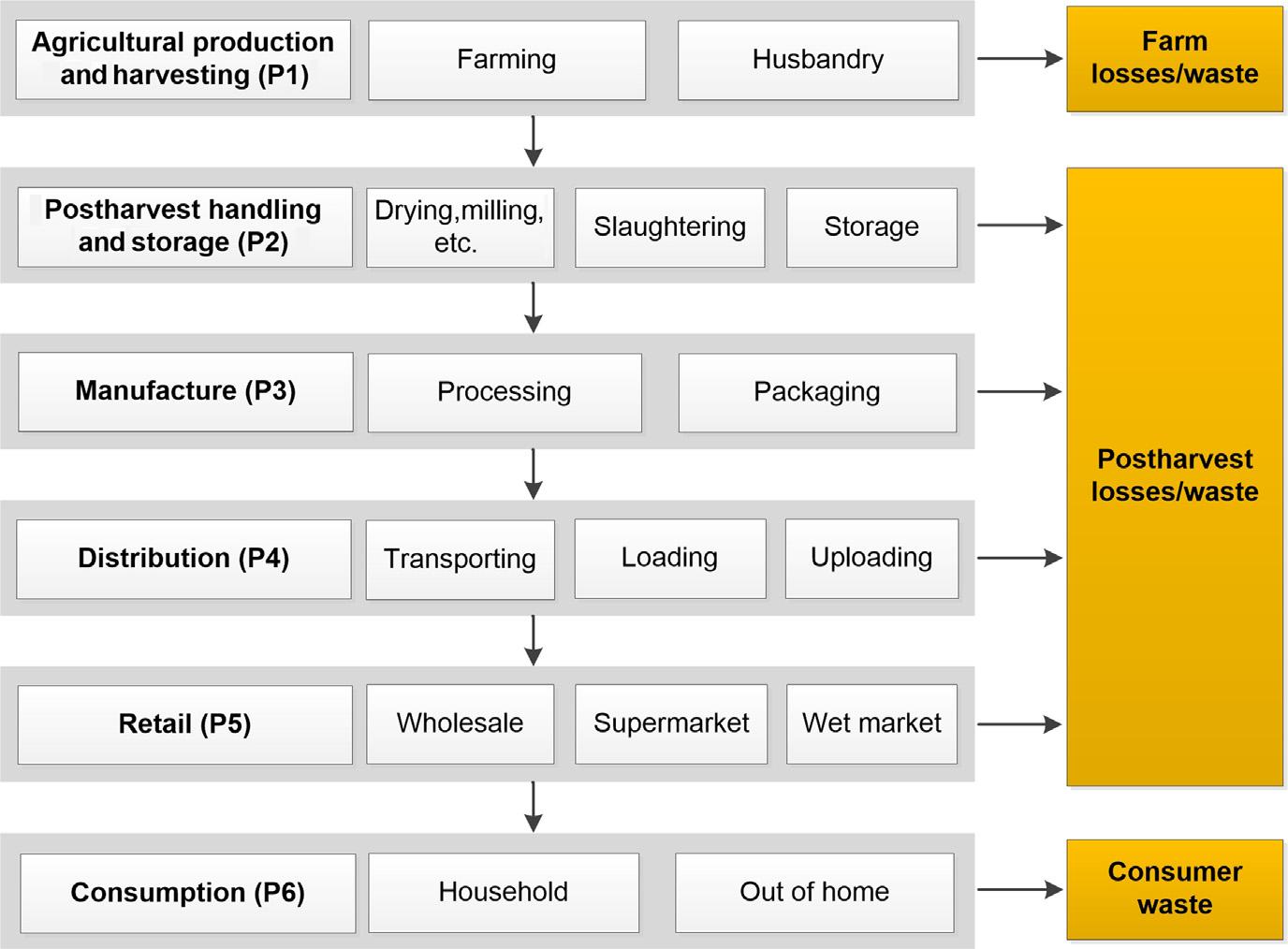
Figure1.1 Foodsupplychainforfoodlossesandfoodwaste.
1.2.3Foodcommoditygroups
ThecommoditiescategoriesweredefinedbasedontheclassificationofFAOand bytakingconsiderationofcharacteristicsofdatainthepublications.Asaresult,10 groupsoffoodcommoditieswerepresented:
1. Cerealandcerealproducts(e.g.,wheat,maize,andrice);
2. Rootsandtubers(e.g.,potatoesandcassava);
3. Oilseedsandpulses(e.g.,peanutsandsoybeans);
4. Fruits;
5. Vegetables;
6. Meat;
7. Fishandseafood;
8. Dairyproducts; 9. Eggs; 10. Othersornotspecified.
1.2.4Geographicalandtemporalboundary
TheFLWdatawascollectedfromasearlyaspossibleto2015attheglobal, regional,andnationallevels.BasedonpercapitaGDPandtheclassificationprinciplesofFAO(Gustavssonetal.,2011),thecountriesaredividedintomedium/highincomecountriesandlow-incomecountries(Table1.1).
Table1.1 Groupingofdifferentdevelopmentlevelsofcountries
Medium/high-incomecountriesLow-incomecountries
ArmeniaLithuaniaAngolaMalaysia
AustraliaLuxembourgArgentinaMexico
AustriaMaltaBangladeshMyanmar
BelarusNetherlandsBeninNepal
BelgiumNewZealandBoliviaNigeria
BulgariaNorwayBrazilPakistan CanadaPolandCambodiaPeru ChinaPortugalCameroonPhilippines
CyprusRomaniaChileSaudiArabia
CzechRepublicRussiaColombiaSouthAfrica
DenmarkSingaporeCostaRicaSriLanka
EstoniaSlovakiaEgyptSwaziland
FinlandSloveniaEthiopiaTanzania FranceSouthKoreaGhanaThailand
GermanySpainIndiaTogo
GreeceSwedenIndonesiaTurkey
HungarySwitzerlandIranUganda
IrelandUnitedKingdomJamaicaVenezuela
ItalyUkraineKenyaVietnam
JapanUnitedStatesLaosZambia
LatviaMadagascarZimbabwe Malawi
1.3Foodlossesandfoodwastequantification
1.3.1Bibliometricanalysisofliterature
1.3.1.1Typeofpublications
WebofScienceandGoogleScholarwerethemainsourcefortheresearch,and reportsissuedbyresearchinstitutionsaswellasgovernmentalornongovernmental organizationswerealsocollectedtoensureawidercoverageofavailabledata. Finally,202publicationswerereviewed.Theyincludefivetypes:peer-reviewed journalarticles(53.5%),reports(35.6%),PhDandmaster’stheses(5.9%),conferenceproceedings(3.0%),andbookchapters(2.0%).Journalarticlesweredominant (108)inthereviewedpublications,whichwerepublishedin69differentjournals andcoveredawiderangeofsubjects.Intotal,approximately45%ofthemwere publishedinthetop10journals(Fig.1.2).Themajorityofthepublications outletswere WasteManagement, WasteManagement&Research, Resources, ConservationandRecycling, FoodPolicy,and JournalofCleanerProduction, representing15.7%,7.4%,5.6%,4.6%,and2.8%ofthetotalpublishedarticles, respectively.
Figure1.2 Thetop10journalsthatpublishesfoodlossandfoodwastedata.
1.3.1.2Temporaltrendforyearofpublicationsandestimation
Fig.1.3A showsthenumberofpublicationsduringthe76-yearperiod(1939 2015). Ingeneral,thenumberofpublicationsi ncreasedthroughoutthewholeperiod.It wassmallandremainedstablebefore 2000.Afterwards,ithasseenagradual increaseduring2001 10.Inthelastfiveyears,thenumberofstudieshasgrown substantially(137),accountingfor67. 8%ofthetotalpublications.Thismeans thereisanincreasingfocusonFLWresearcharoundtheworld.
Fig.1.3B illustratesthetimetrendoftheyearofestimation.Accordingtoliterature, theFLWdatawasdiscoveredasearlyas1933,andthenumberremainedstableand lowuntil1995.Afterwards,thenumberhas increasedsignificantlybymorethan60% overthepast10years,38.1%from2006to2010and25.1%from2011to2014.
1.3.1.3Distributionofcountries
The202publicationsreportedFLWdatathroughoutthefoodsupplychaincovering 84countries(reported498times)distributedallovertheworld.However,thefocus onFLWwasunbalancedindifferentregions.Moststudieswereconductedinthe developedareas,suchasNorthAmerica,NorthernandWesternEurope,whereaslittle attentionwaspaidtothedevelopingcountries,suchasIndia. Fig.1.4 showsspatial distributionandthetop10countrieshavebeenstudied.Mostresearchwasconducted intheUnitedKingdom(Langleyetal.,2010;Menaetal.,2014;Vanhametal.,2015; Xuetal.,2015)andUnitedStates(Thybergetal.,2015;BuzbyandHyman,2012; Kantoretal.,1997),bothofwhichmadeupmorethan10%ofthereportedtimes, respectively.ThenSweden(Br ¨ autigametal.,2014;FilhoandKovaleva,2015), Germany(Kranertetal.,2012;Jorissenetal.,2015),andFinland(Silvennoinenetal., 2012;Silvennoinenetal.,2015)accountedfor5.4%,4.4%,and3.2%,respectively.
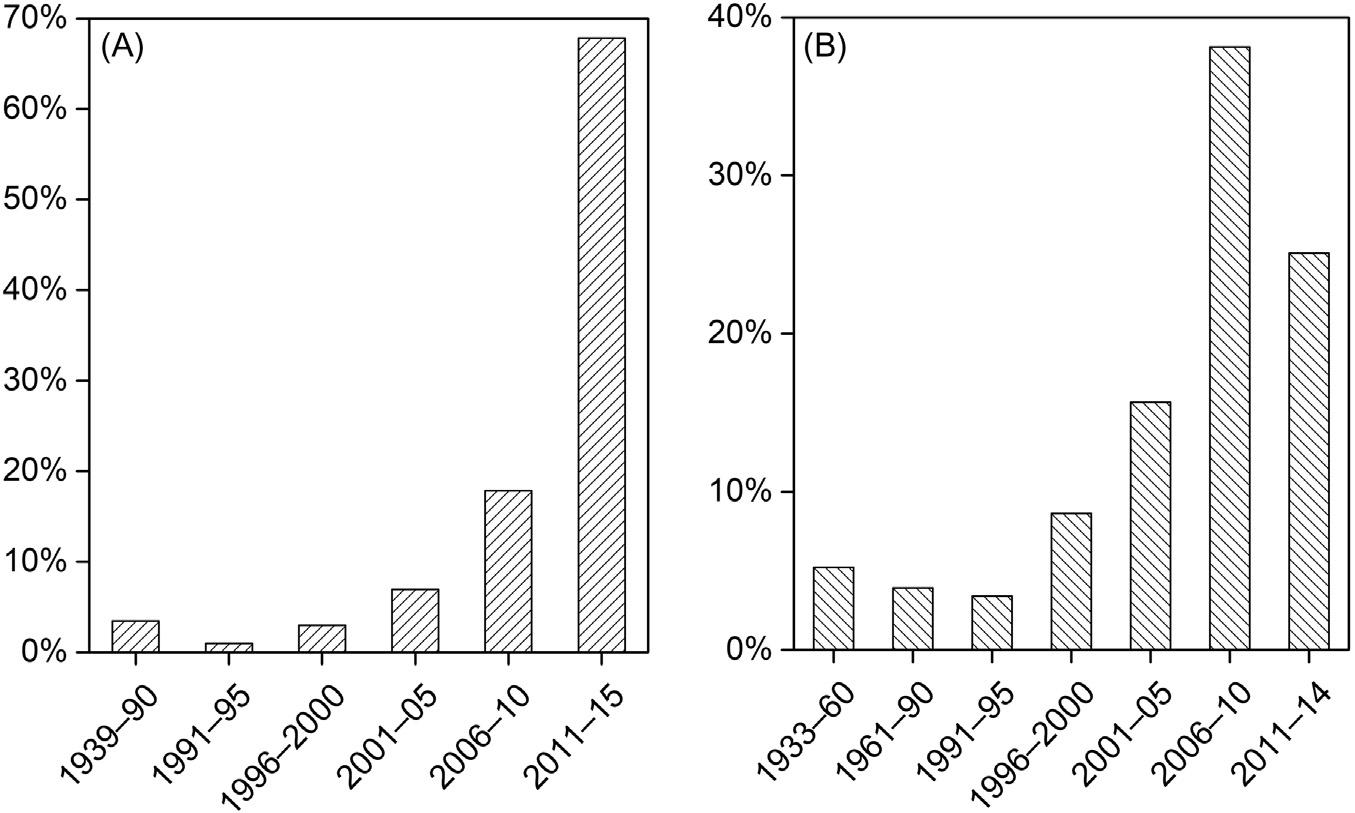
Figure1.3 (A)Temporaltrendofreviewedfoodlossesandfoodwaste(FLW)dataintermsof yearofpublication.(B)TemporaltrendofreviewedFLWdataintermsofyearofestimation.
Figure1.4 Geographicaldistributionofcasecountries.Thenumbersarethereportedtimes ofindividualcountries.
Source:AdoptedfromXue,L.,Liu,G.,Parfitt,J.,Liu,X.,VanHerpen,E.,Stenmarck,A
., etal.,2017.Missingfood,missingdata?Acriticalreviewofglobalfoodlossesandfood wastedata.Environ.Sci.Technol.51(12),6618 6633.
1.3.1.4Foodsupplychaincoverage
Accordingtothepublicationsfound,theycovereddifferentstagesinthefoodsupplychainintermsofmedium/high-incomecountriesandlow-incomecountries.
Fig.1.5 showsthatmoststudiescoveredtheretailingandconsumptionstages.In total,thelargestnumberofstudieswerecarriedoutinhousehold,accountingfor
Figure1.5 Thenumberofpublicationsintermsofdifferentfoodsupplystagesanddifferent developmentlevelsofcountries.
49%ofallthepublications,whichwasfollowedbytheretailingstages(35%). However,onlyasmallportionofstudiesincludedthestagesbetweenagricultural productionanddistribution.Indetail,agriculturalproduction,postharvesthandling andstorage,manufacturing,anddistributionstagesaccountedfor26.7%,18.8%, 28.7%,and21.8%,respectively.
Inthecaseofregionstudied,thenumberofpublicationsinmedium/high-income countrieswasmuchhigherthanthatinlow-incomecountriesalongthefoodsupply chain,apartfromthepostharvesthandlingandstoragestagewiththesamenumber ofpublicationsforboth.Themajorityofstudiesinvolvingretailingandconsumptionstageswereconductedinmedium/high-incomecountries,occupying31.2% and42.6%ofalltheliterature,respectively.Ontheotherhand,low-incomecountriesweretargetedmainlyintheearlyandmiddlestagesofthefoodsupplychain, especiallyfortheagriculturalproductionandpostharvesthandlingandstorage stages. 1.3.2Differentmethodsusedforfoodlossesandfoodwaste
1.3.2.1Overviewofmethods
TherewerevariousmethodsusedtomeasurethequantityofFLWalongthefood supplychain. Table1.2 summarizesthemethodsusedtoquantifyFLW.Twokinds ofmethodologieshavebeenusedtoquantifyFLW,whichcanbedividedintotwo
Table1.2 Descriptionofdifferentmethodsusedforfoodlossesandfoodwastequantification
MethodSymbolExampleofcase countries/regions
Direct measurement
Indirect measurement
FoodsupplychainReferences
WeighingWPortugalP6b Dias-Ferreiraetal.(2015)
GarbagecollectionGAustriaP6a Dahle ´ nandLagerkvist(2008)
SurveysSUnitedKingdomP1,P2,P3,P5 Menaetal.(2014)
DiariesDUnitedKingdomP6a Langleyetal.(2010)
RecordsRSwedenP5 Scholzetal.(2015)
ObservationOItalyP6b Saccaresetal.(2014)
ModelingMUnitedStatesP6 Halletal.(2009)
FoodbalanceFGlobalP1,P2,P3,P4,P5,P6 Gustavssonetal.(2011)
UseofproxydataPSingaporeP6a GrandhiandAppaiahSingh(2016)
UseofliteraturedataLDenmarkP1,P3,P4,P6 Halloranetal.(2014)
Note:P6a 5 Household,P6b 5 Out-of-home.
groups:(1)directmeasurementorapproximationbasedonfirst-handdata,and(2) indirectmeasurementorcalculationderivedfromsecondarydata.Thesemethods couldprovideaninsightoforiginsandspecificstagesinthewholefoodsupply chainofFLW,oranoverviewofFLWattheregionalorgloballevelfromamacroperspective.Detailedinformationonthemethodsusedisoutlinedasfollows: Directmeasurementinvolvesavarietyofmethodstoquantifyorestimatethe amountofFLW:
● Weighing:Itisusuallyusedinrestaurants,hospitals,andschoolviainstrumentordevice tomeasuretheweightofFLW.ItmayormaynotinvolveweighingeachpartofFLWfor thecompositionalanalysis.
● Garbagecollection:Thisinvolvesseparationfromothertypesofresidualwastescollected todeterminetheweightorproportionofFLW.Itmayormaynotinvolvecompositional analysisofFLW.Itcanbecollectedfromhouseholds(Gutie ´ rrez-BarbaandOrtega-Rubio, 2013).
● Surveys:Questionnairesareusedtocollectinformationaboutperceptionsandbehaviors onFLWansweredbyagreatmanyindividuals,orbyface-to-faceinterviewswithmajor stakeholdersinthefield.Thisusuallytakesplaceinhouseholds,wherepeoplecandirectly estimatethequantityoffoodwasteorthepercentageoffoodpurchasedthatgoestowaste intheirfamilies(Stefanetal.,2013).
● Diaries:Itisoftenusedinhouseholdsandcommercialkitchensbyrecordingthequantity ofFLWforacertaintime,whereweighingscalesaresometimesusedtoquantifythe amountofthefoodwaste(RathjeandMurphy,2001).
● Records:Itisusuallyusedintheretailingandmanufacturingstages,especiallyforsupermarketsandlarge-scalefoodcompanies,whereregularcollectionofinformation(notinitiallyusedforFLWrecord)candeterminethequantityofFLW.
● Observation:VisuallyestimatingtheamountoffoodleftoverbyusingscaleswithmultiplepointsorassessingthevolumeofFLWbycountingthenumberofgoods.
Theothergroupincludesmethodsbasedontheexistingdatafromdifferentsecondarysources:
● Modeling:ItusesmathematicalmodelstoobtaintheamountofFLWonthebasisofthe factorsthataffectFLWgeneration.
● Foodbalance:Usingfoodbalancesheet(e.g.,FAOSTAT)basedoninputs,outputs,and stocksinthefoodsupplychaintocalculateFLW,orhumanmetabolism(e.g.,therelationshipbetweenbodyweightandtheamountoffoodeaten).
● Useofproxydata:Usingdatafromcompaniesorstatisticalinstitutions(inanaggregated level)toestimatetheamountofFLW.
● Useofliteraturedata:UsingdatafromliteraturedirectlyorestimatingquantitiesofFLW accordingtothedatainotherliterature.
Fig.1.6 showsthemethodsusedinthe202publications.Itcanbeseenthat mostofthepublicationsdependedontheindirectmeasurement(red-yellow(dark grayinprintversion)colorsin Fig.1.6).Morethan40%ofthemwereonlybased onliteraturedata,andaboutone-thirdusedothertypesofmethodswithliterature data,forinstance,modeling(KhanandBurney,1989;Liuetal.,2013)orproxy data( Gooch,2012;Anetal.,2014)(indirectmeasurement)orweighingorsurveys( Papargyropoulouetal.,2014;Edjabouetal.,2015)(directmeasurement).
Figure1.6 Anoverviewofthemethodsusedinthereviewed202publications.Eachcircle indicatesonepublication,andthecolorsrepresentdifferentmethodsused.Direct measurementincludes:weighing(W),garbagecollection(G),surveys(S),diaries(D), records(R),andobservation(O).Surveysalsocontainquestionnaires,interviewsand experts’estimation.Indirectmeasurementinvolves:useofliteraturedata(L),useofproxy data(P),foodbalance(F),andmodeling(M).
Source:AdoptedfromXue,L.,Liu,G.,Parfitt,J.,Liu,X.,VanHerpen,E.,Stenmarck,A ˚ ., etal.,2017.Missingfood,missingdata?Acriticalreviewofglobalfoodlossesandfood wastedata.Environ.Sci.Technol.51(12),6618 6633.
Onlyasmallfractionofth epublicationsdependedonthedirectmeasurement. Inaddition,forthe138publicationsusingliteraturedata,theyoftendepended oneachotherandsomepublicationshavebeenhighlycited.Morethanonefourthofthemreferredtothedatafromthetop10publicationscited,andthe numberofcitationshasgreatlyincreasedsince2008( Fig.1.7 ).ThehighpercentageofusingthesecondarydatamayindicatethattheavailableglobalFLWdatabasehashighuncertainties,especiallywhenthereislackoforiginaldatafor acertaincountryoracertainyearbutliteraturedatathatarenotrepresentative areused.
1.3.2.2Advantagesanddisadvantagesofmethods
Table1.3 liststheadvantagesanddisadvantagesofdifferentmethodsbasedon somecriteria(e.g.,time,cost,andaccuracy).
● Weighingandgarbagecollectioncanproviderelativelydetailed,objective,andaccurate informationoffooddiscarded.ThesetwomethodsmayleadtofullquantificationofFLW andcanproducemoredetaileddataatthefoodtypeslevel.However,theycanbe
Figure1.7 Thecitationnetworkofthe138publicationsthatusedliteraturedata.Eachdot indicatesonepublication.Thesizeofthedotrepresentsthenumberofcitations,andthe arrowrepresentsthedirectionofcitation.Thedotsinwhiteontherightrepresent publicationsoutsidethecitationnetwork.Thetop10citedpublicationsare:(1) Kantoretal. (1997);(2a) WRAP(2009);(2b) Gustavssonetal.(2011);(3a) WRAP(2008);(3b) Monier etal.(2010);(3c) BuzbyandHyman(2012);(4a) Kader(2005);(4b) Kranertetal.(2012); (5a) Buzbyetal.(2009);(5b) Langleyetal.(2010).
Source:AdoptedfromXue,L.,Liu,G.,Parfitt,J.,Liu,X.,VanHerpen,E.,Stenmarck,A
., etal.,2017.Missingfood,missingdata?Acriticalreviewofglobalfoodlossesandfood wastedata.Environ.Sci.Technol.51(12),6618 6633.
performedonlywhenspaceavailableforclassifyingfoodandwithdevicetoweigh,and theyarealsomoretime-consumingandexpensivethanothermethods.Forexample,a studyonfoodwasteinrestaurantswasconductedinfourChinesecasecities(Beijing, Shanghai,Chengdu,andLhasa)in2015,whichdirectlyweighedfoodwastefrom3557 tablesin195restaurantsofdifferentcategories,includinglunchanddinnerbyindividual items.Itisestimatedthatfoodwastepercapitainrestaurants(approximately11kg/cap) isclosetotheaveragelevelofWesterncountries.Thisisafirstapproximationofthe scalesandpatternsofrestaurantsfoodwasteinChinesecities,whichcanhelpinformthe strategiesonfoodwastereduction(Wangetal.,2017).Inaddition,theaccuracyofwaste compositionanalysisreliesonthemethodsused,andithasidentifiedvarioussourcesof error(LebersorgerandSchneider,2011).
● Surveys,diaries,records,andobservationareotherwaysofdirectmeasuringand approximatingFLWdata,whichconsumeslesstimeandcostsmorethanweighing. However,duetosomefactorssuchaspers onalviews,thewayofrawdatacollection,
Table1.3 Advantagesanddisadvantagesofdifferentmethodsusedforfoodlossesandfoodwastequantification
andsubjectivityofobservers,theaccuracyofthedatacollectedmaybelower.Surveys thatincludequestionnairescanbecompletedbyemailorbyphone,orbyface-to-face interviewsandexpertestimation.ButbiasesmayoccurinFLWestimationbecausethis methoddependsonthememoryofpeopleand theymayprovideanswersthatthesocietyexpects.Forexample, Nazirietal.(2014) conductedquestionnairesurveys,focus groupdiscussion,andkeyexpertinterviewsonpostharvestlossesofcassavaduring JulyandOctober2012infourindividualdevelopingcountries(Ghana,Nigeria, Thailand,andVietnam)toinvestigatetheamountoflossesandexploremitigationstrategies.Diariescanbeaheavytaskforparticipants,andcausegradualdeclineofparticipants’enthusiasm( Langleyetal.,2010 ),aswellasdifficultiesinrecruitmentandhigh dropoutrates( Sharpetal.,2010).Inaddition,keepingdiariesmayhaveinfluenceson changesinawarenessandbehavior,whichw illleadtouncertainaccuracyofthediaries ( Sharpetal.,2010).Forexample,toanalyzethecompositionoffoodwasteinthe UnitedKingdomhouseholds, Langleyetal.(2010) asked13householdstokeepadiary for7days,recordingtheinformationonthetype,origin,andweightoffoodwaste. RecordsoftencostlessandtakelittletimetogetFLWdata.Observationisarelatively quickwaytoestimateFLW,buttheaccuracyandreliabilityarequestioned.
● Becauseoflowcostandhighfeasibility,secondarydataiswidelyusedtomeasurethe amountofFLW.Butthereishigheruncertaintyamongthesemethods.Formodeling,the choiceofmodelparametersandtherelationshipbetweenthesefactorsandthequantityof FLWwouldlargelyaffecttheresults.Forfoodbalancemethod,theaccuracyisdeterminedbythequalityandcomprehensivenessofthefoodbalancesheetdata.Themost cost-effectiveandfeasiblewaytoobtaindataisbyusingproxydataandliteraturedata, however,theiraccuracyprimarilyreliesonthequalityandrepresentativenessofthe sourcedataused.Ifthedataareuncertainandinaccurate,theresultswouldalsonotbe reliable.
Inreality,nodirectorindirectmethodscanbesatisfactory.Despitetheadvantages,directmeasurementusuallyinvolvesalimitednumberofparticipantsina certaincommunityorcityandacertainstageofthefoodsupplychain,whichcould leadtoanunavoidableproblemofdeficiencyofrepresentativeness,especiallyfor thelargecountriesliketheUnitedStatesandChina.Ontheotherhand,indirect measurementcanprovideanoverviewoftheentirecountryandvariousstages.A combinationofdirectandindirectmeasurementcouldbeabetterchoicetoillustratetheFLWproblem.Forpolicymakingandmitigationstrategies,basedonthe statisticaldataatthenationalorregionallevelitcoulddeterminetheseverityofthe problem.Forthedesignofeffectiveinterventionsteps,usingfirst-handdataand exploringthedrivingandinfluencingfactorscouldbeagoodapproach.
ThechoiceofmethodhasasignificantimpactontheFLWquantification,which couldresultindatadisparityintheliteratureexamined.Forexample,itwas reportedthatthefoodmanufacturingindustryinItalyproducedabout5.7million tonnesofFLWin2006(Monieretal.,2010),whileanotherstudybasedonmodelingestimatedabout1.9milliontonnesofFLWforthissector(Brautigametal., 2014).Suchbigdifferenceexistsbetweenthembecausetheyuseddifferentdata sourcesandassumptions.TheformeroneincludedFLWandrecycledorreused byproducts,whereasthelatteroneadoptedthelossrateinthemanufacturingsector andthemethodreportedbyFAO(Gustavssonetal.,2013).
1.3.3.1Farmlossesandwaste
Attheagricultureproductionstage,theFLWinlow-incomecountriesisgenerally higherthanthatinmedium/high-incomecountries,becausethereismoreadvanced technologyandinfrastructureforharvestinginrichcountries.Forexample,itis reportedthatFLWatthisstageaccountsforthelargestportion(26%)ofthetotal FLWinSouthAfrica(SpeschaandReutimann,2013)whereasitmakesup13%ofthe overallFLWacrossthefoodsupplychaininCanada(NahmananddeLange,2013).
Accordingtotheexistingdata,thereislittleinformationonFLWoffoodcommoditiesintheagriculturalproductionandharvestingstage.Fordifferentfoodcategories,onapercapitalevel,cereallossisthelargestwithamedianofroughly 16kg/cap.Forexample,itisreportedthatabout5% 9%ofcerealwaslostatthis stageinChina,andasimilartrendcanbeseeninGhana(WorldBank,2011). Fruitsandvegetablesarethesecondlargestwastedcategoryatthisstagewitha valueof13kg/cap.However,thereisasignificantdifferenceoffruitand vegetablelosses/wastebetweenlessdevelopedandindustrializedcountries.For example,fruitandvegetableFLWmadeupabout20% 30%ofthetotalproductioninChina(Liu,2014)whileitaccountedforonly6% 15%atthisstageinItaly (Segre ` etal.,2014).Thereasonforthebigdifferenceisthatmoreadvancedand newertechnologiesareusedindevelopedcountries.ThereisasmallfarmFLWof meatandfish,dairyproducts,andeggsattheproductionlevel(Fig.1.8).
1.3.3.2Postharvestlossesandwaste
PostharvestFLWoccursduringthepostharvesthandlingandstorage,manufacturing,distribution,andretailingstages,wheredistinctivecharacteristicscanbeseen
Figure1.8 Percapitafarmfoodlossesandfoodwasteofdifferentfoodcommodities.

